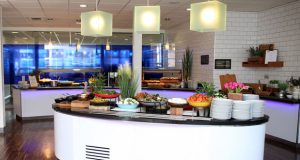With the increase in hybrid work, access-card swipes, WiFi logins and occupancy sensors are the new data currency for companies rethinking office design, according to a new study by global real estate advisor, CBRE.
The study found that companies are more closely tracking their use of their office space, with 90 per cent of respondents saying they now routinely gather utilisation data in order to better understand why, when and how employees are using the office.
CBRE’s findings are adding momentum to trends of larger workstations, fewer private offices, more use of desk-reservation systems and a greater emphasis on shared space and amenities. In total, 60 clients of CBRE’s Occupancy Management practice participated in the benchmarking program, which gauges their plans for the size, use and functions of their offices. These companies cumulatively occupy 493 million sq. ft. of office space across the globe.
Such monitoring and analysis of companies’ use of office space equips those companies to make decisions about how to allocate their office space to various uses and whether to expand or shrink their overall office portfolio. To that end, 87 per cent of companies in the study aim to optimise their office portfolio to better fit their patterns of use.
Susan Wasmund, CBRE Senior Managing Director and Global Occupancy Management Lead commented: “The increase in hybrid work means greater importance for occupancy management, defined as continual, real-time analysis of how – and how often – companies use their office space. Employee’s workstyles have changed more in the past two years than in the previous 20. Companies that measure space utilisation have a better understanding of employee preferences and work habits, making it easier for them to design spaces that attract employees back to the office.”
With greater hybrid work, office-space allocation now is leaning more toward collaborative, ‘we’ uses, such as teamwork pods, huddle rooms and lounges. Companies in the study are dedicating an average of 16 per cent of their office space to such collaborative uses, up from 13 per cent last year. In contrast, space assigned to ‘me’ uses such as private offices and assigned desks declined to 40 per cent this year from 53 per cent last year.
Meanwhile, space allotted for support functions and for amenities such as cafeterias, coffee counters and walk-up tech support increased several percentage points this year to 30 per cent and 14 per cent of floorspace, respectively.
Georgia Collins, CBRE Americas Consulting Leader said: “Companies used to plan their office space based on historic data, which sometimes was subjective. They now can use more objective, real-time data to manage their office space more dynamically. That generates greater efficiency and performance over time for their employees, be they remote, hybrid or mostly office-based.”
Other findings of CBRE’s benchmarking program include:
Workstations are getting larger as companies shift more to unassigned, ‘free address’ seating. Last year, the largest portion of companies (56 per cent)reported their average workstation size at 35 sq. f.t or smaller. This year, the largest contingent (63 per cent)favors the next size up: 35 sq. ft. to 49 sq. ft. CBRE anticipates workstations will get fewer in number as they get larger in size to accommodate the type of work that hybrid employees need to do while in the office.
Private offices may be falling out of favour. Thirty-one per cent of companies don’t include offices in their design standards, meaning offices aren’t among their most common space types. That’s up from 25 per cent last year.
Shared space often functions best with reservations. Reservation systems for meeting rooms isn’t a new trend. But many companies are taking that a step further by providing daily reservations for desks and workstations. The 54 per cent of companies offering desk-reservation systems represent double last year’s share.
Most companies measure office utilisation in multiple ways. Ninety-one per cent monitor access-badge swipes, 34 per cent use visual observation, 32 per cent assess corporate WiFi logins, 23 per cent use ceiling-mounted sensors and another 15 per cent use threshold sensors. Seventy per cent use two or more utilisation sources.
To read the 2022-2023 CBRE Global Workplace & Occupancy Insights report, click here.
Developing an effective workplace experience is a balancing act.
This years annual insight report delves into the work-life balance we now face in our day-to-day lives. How the new hybrid working world sees us challenge the balance of getting these things right and what workplaces can do to support its colleagues.
Find out how your organisation can get it right by clicking here to download Balanced Workplaces, a Claremont Group Interiors Insight Report Issue 6.





